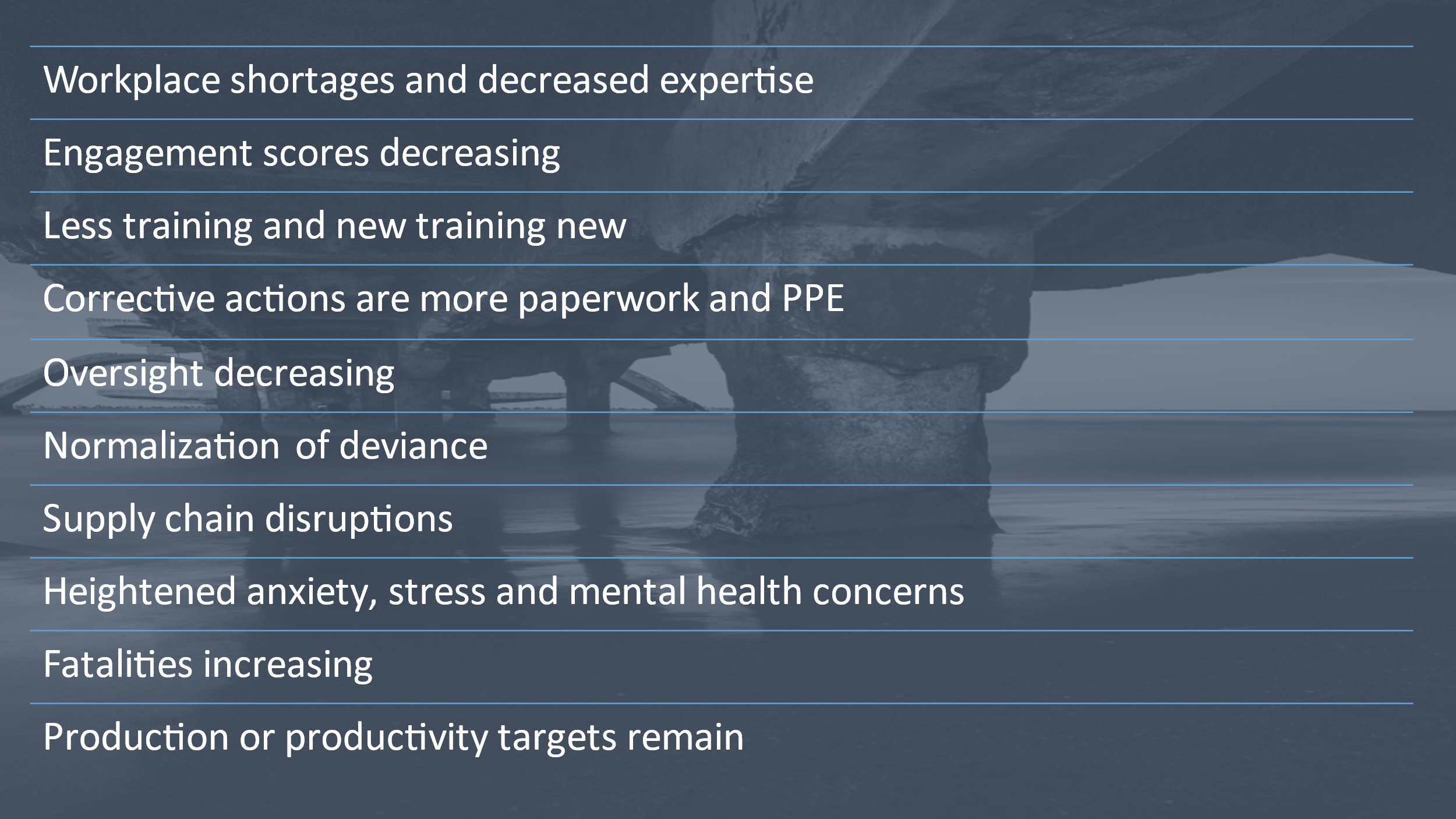EHSToday - October 2023
By: Shawn M. Galloway
Printable Version
Workplaces have changed (some drastically) since 2020, making previous safety strategies obsolete. We must change our approach to meet these new realities; otherwise, we can expect broader organizational challenges in the days ahead. Ten new trends are significantly impacting overall performance and culture in most industries. A new strategy is needed.
In my 2023 book, Bridge to Excellence: Building Capacity for Sustainable Performance, I outlined what it takes to build sustainable excellence within a business using the metaphor of building a bridge. I also cautioned readers or listeners of the book that constant inspection and maintenance are required as unexpected things will inevitably occur that will stress the bridge. As such, I've been on the constant lookout for potential stressors. Unfortunately, I've found them everywhere, and they are not just impacting safety performance and safety culture. The following are the indicators (trends) observed in many workplaces that concern me and should concern you.

- Workplace shortages and decreased expertise. This is seen in attrition, increasing attendance issues, and reducing average knowledge levels and competencies.
- Engagement scores are decreasing, and active disengagement is increasing, especially with remote employees' connection to their organization's mission and purpose.
- Less training and new training new. There is decreased time training new employees in their work, and new employees training new employees. This creates cultures of decreased understanding of hazards and risks associated with the work.
- Corrective actions are more paperwork and PPE. When comparing thousands of corrective actions taken after an injury against the hierarchy of controls, most fall into the additional administrative controls or PPE category. With this theme added to the reality of newer people entering a company whom other new employees train, this creates additional error-like situations.
- Oversight decreasing. This is observed with first and second-line supervision and safety professionals not in the field or on the floor as much as needed to observe work as it occurs and proactively seek out deviations to address influences before they result in an unwanted event. Additionally, in several organizations, the experience levels of these leadership groups are also decreasing. This results in less technical or operational knowledge of the standards by which the work should be performed safely.
- Normalization of deviance. The previous seven themes contribute to many operational environments where it is becoming culturally normal to perform work incongruent with the standard or how the work was planned.
- Supply chain disruptions continue. This results in increasing stress with operational leaders who still need to meet production or productivity targets, leading to workers performing the work without necessary parts, equipment, chemicals, etc., and in several organizations, this is observed in work being performed out-of-scope or out-of-process.
- Heightened anxiety, stress, and mental health concerns. The suicide rate has increased over the past ten years. If that isn't concerning enough, tensions are increasing in the workplace and the broader community, leading to concerns about unintentionally triggering someone, and many operational leaders privately voicing to me their hesitancy to stop a job or talk to an employee about unacceptable, unsafe, or at-risk behavior.
- Fatalities are increasing. Despite the attention placed on proactively identifying and mitigating potential serious injury or fatality (SIF) exposures, America's occupational fatality rates are increasing.
- Production or productivity targets remain. Despite the reality of the new workplaces and the evidence of the previous eight themes, few organizations have reduced their production or productivity targets, creating additional opportunities for error-likely situations. Additionally, with these nine previous new realities, leadership expects safety performance to continuously improve.
When we are surprised by undesirable results, we are often either blind to the indicators or are not giving them their deserved attention. Undesirable safety performance is often a symptom of larger issues in the broader workplace and organizational culture. When safety performance continues to trend poorly, we also find deviations from quality, delivery, reliability, efficiency, or cost expectations. When this becomes the new reality, it is no longer a safety problem; it is an organizational problem requiring operational leadership to get involved and develop a new strategy broader than a safety improvement plan. Consider reviewing these observed trends with your leadership team. Is your safety and overall business strategy aligned and prepared for today's realities?

Shawn Galloway, CEO of ProAct Safety, is an expert in safety excellence. With almost thirty years of experience, he is a highly sought-after advisor, keynote speaker, and expert witness. Shawn has become a trusted partner to leading organizations across various industries worldwide. He ranks in the top 1% of the most prolific writers in his field, having authored over 500 articles and several bestselling books. He also launched the world's first safety podcast, Safety Culture Excellence©. As a recognized authority in safety, Shawn has received awards such as being named among the Top 50 People Who Most Influence EHS and a Top 10 Speaker, among others.
He is a regular guest on Bloomberg, Fox News, The Daily Mail, Dubai One, U.S. News & World Report, Sirius Business Radio, Wharton Business Daily, and leading safety magazines and podcasts. Shawn also serves as a member of the Harvard Business Review Advisory Council, Forbes Business Council, and Fast Company Executive Board, enabling his influence to shape safety thinking and strategy at the executive level.
